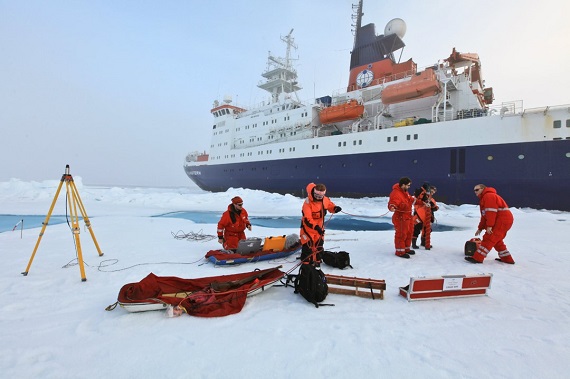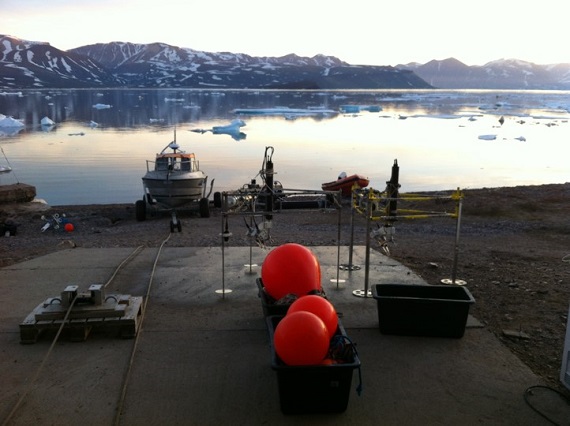
Will The Arctic Ocean flourish with new life when the ice melts?
The Arctic Ocean is one of the most rapidly warming regions on Earth and is headed towards being ice free in the summer. However, this provides opportunities for new ecosystems to develop, biologist Karl Attard argues.
The ice in the Arctic is melting quickly, especially in summer. But from an ecosystem perspective, the melting of sea ice can also benefit certain species.
Less ice in the Arctic in the summer will allow the sun's rays to penetrate the sea and stimulate photosynthesis, which could provide better opportunities for certain plants and marine animals.
This is the perspective from Karl Attard, Assistant Professor in Marine Science at the Department of Biology at the University of Southern Denmark, who researches the marine environment in the Arctic.
- Plants in the sea need sunlight for photosynthesis. As the amount of sea ice in the Arctic decreases, more light will penetrate the oceans and boost photosynthetic growth. The melting ice will probably create a different, more productive ecosystem, says Karl Attard, and continues:
- With my research, I would like to come up with an answer to what an ice-free Arctic Ocean in summer will look like. Will it become an oasis of life?
Attard is researching the conditions of the marine environment, and he is particularly interested in ecosystems on the seabed, which he has studied on several occasions while on expeditions in the Arctic.
Polar bears and seals will likely disappear from the Central Arctic
Due to ongoing climate change, which is heating up the Arctic region three times faster than the global average, summer ice cover in the Arctic has fallen by 12 pct. per decade over the past 30 years. Forecasts show that major Arctic coastal seas will become ice-free within the next 5-10 years, and the ice pack might disappear completely in the summer as early as 2035.
Losing the sea ice will mean that the entire ice ecosystem, which is a characteristic feature of the Arctic, disappears in the summer. According to Attard, Polar bears, seals and other organisms that live their entire life cycle on the ice will have the solid base under their feet replaced by deep, cold water.
- On the other hand, less ice will allow more sunlight to penetrate the Arctic Ocean, which increases photosynthesis and makes the ecosystem more productive, Attard says.
- However, it is not a linear process. For instance, we can expect that less ice and increased storms, which is also expected in the Arctic, will expose the seabed to waves and currents, which will increase the turbidity of water and counteract the increased availability of sunlight to some extent.

Research near the North Pole aboard the German research vessel RV Polarstern (Photo: Karl Attard)
More fish and better trade routes?
Less ice and more plants in the ocean will likely create better opportunities for fisheries that rely on open waters, Attard continues:
- The consequences of the melting ice are varied. Often, we look at something and think: Is this a good or a bad thing? With this issue, it depends entirely on your perspective. There are important nuances to consider in a balanced debate, and I hope that my research can contribute to this discussion.
In addition to ecosystem changes, we can according to Attard expect an ice-free Arctic in the summer to have far-reaching economic, socio-cultural, public health and geopolitical consequences.
- For instance, how will the melting ice affect international trade, when new reliable shipping routes linking Asian markets to European waters become available through the Arctic? And how will this increased activity in turn affect Arctic ecosystems? These questions necessitate interdisciplinary discussions that consider sea ice forecasts, supply chain operations, and governance.
Therefore, the consequences must be investigated in an interdisciplinary setting and include researchers in a wide range of areas.

Equipment ready for deployment in Young Sound Research Station, Northeast Greenland (Photo: Karl Attard)
Icebreakers and access
To get a more detailed overview on what an ice-free Arctic will look like in the summer, more expeditions to the Arctic are needed.
Using ice-breaking ships, researchers could access distant field sites to describe the biological processes to fill important knowledge gaps.
- One of the challenges of working in the Arctic is that we only have access to relevant research areas for a few months in the summer, he says.
Therefore, there is a need to set up sensors that make it possible to record and transmit data in real time all year round – for example by using observatories.
- The data sets we will be able to create in this way, combined with satellite data covering the last 30 years, can eventually be used to create a new generation of models for productivity in the Arctic, which will give us the best opportunities to understand ecosystems in the Arctic now and into the future, Karl Attard says.
Meet the researcher
Karl Attard is a marine biologist and Assistant Professor at the Department of Biology, SDU - currently researching the Arctic Ocean as DIAS Fellow of Marine Science. Attard has participated in more than 30 international expeditions that include the Arctic, the Antarctic, and remote islands in the Pacific and Atlantic Oceans.
What is it you don't understand?

Researchers are constantly learning more about their field - but at the same time there is still a lot they do not yet understand. What is that? And what significance will it have for their research - and for society - to find answers? We ask SDU researchers.